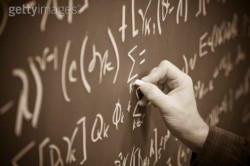Solution to An Unmagic Square?
Correct Solutions: No correct solutions were submitted.
A 3×3 matrix with all its entries from the set {-1, 0, 1} cannot have the sum of all its rows and columns to be distinct.
For suppose such a matrix could be constructed. The possible sums of the rows and columns are -3, -2, -1, 0, 1, 2, and 3. So six of these seven numbers would have to be used. Here are some facts:
-
- The numbers 3 and -3 cannot both be used. If they could, two of the rows (or columns) would have to be [1 1 1] and [-1 -1 -1]. Then, in order to make the sum of the three columns distinct, the third row would have to be some permutation of [-1 0 1]. But then the sum of this row and the sum of the column containing the 0 are both zero. This is a contradiction to all of the sums’ being distinct.
- Without loss of generality, assume -3 is the only missing sum. The numbers 3 = 1 + 1 + 1 , 2 = 1 + 1 + 0, and -2 = (-1)+ (-1) + 0 have unique (except for order of addition) representations as sums of the numbers -1, 0, and 1. The numbers -1, 0, and 1 can be expressed in more than one way by summing the numbers -1, 0, and 1.
- Since the numbers 3 and -2 must be sums of a row or a column, we assume row 1 of the matrix is [1 1 1] and row 2 is [-1 -1 0]. (It is clear that we cannot have one of these as a row and the other as a column.) Since we must have some row or column with a sum of 2, it follows that the last row of the matrix must be of the form [* * 1], where the two starred positions are yet to be determined.
To finish the proof, try each of three cases in turn: First try -1 in the southwest corner of the martix; then try 0 in the southwest corner; and finally try 1 in the southwest corner. None of these cases work.
Therefore the proposed matrix cannot be constructed.

